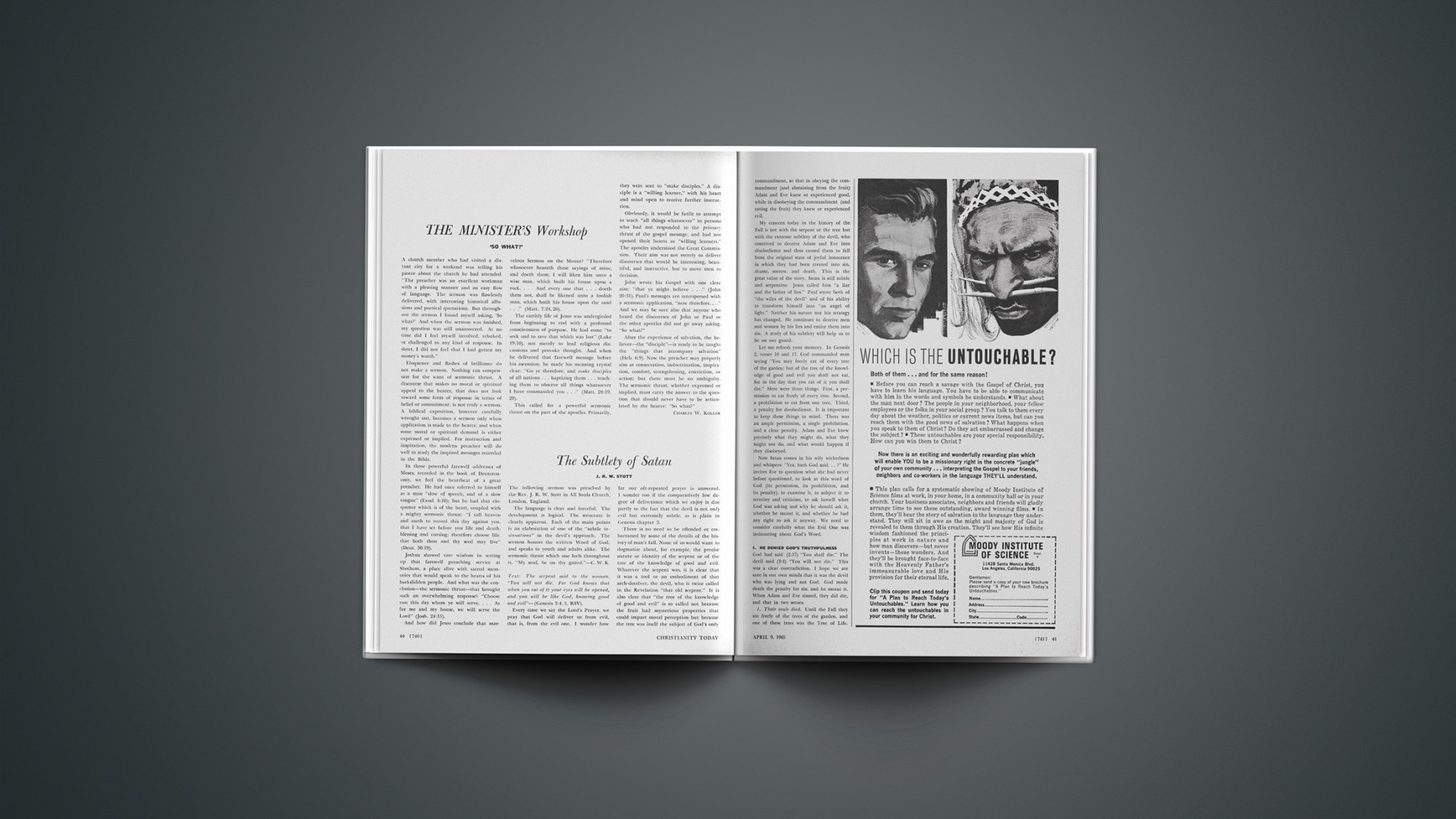A church member who had visited a distant city for a weekend was telling his pastor about the church he had attended. “The preacher was an excellent workman with a pleasing manner and an easy flow of language. The sermon was flawlessly delivered, with interesting historical allusions and poetical quotations. But throughout the sermon I found myself asking, ‘so what?’ And when the sermon was finished, my question was still unanswered. At no time did I feel myself involved, rebuked, or challenged to any kind of response. In short, I did not feel that I had gotten my money’s worth.”
Eloquence and flashes of brilliance do not make a sermon. Nothing can compensate for the want of sermonic thrust. A discourse that makes no moral or spiritual appeal to the hearer, that does not look toward some form of response in terms of belief or commitment, is not truly a sermon. A biblical exposition, however carefully wrought out, becomes a sermon only when application is made to the hearer, and when some moral or spiritual demand is either expressed or implied. For instruction and inspiration, the modern preacher will do well to study the inspired messages recorded in the Bible.
In those powerful farewell addresses of Moses, recorded in the book of Deuteronomy, we feel the heartbeat of a great preacher. He had once referred to himself as a man “slow of speech, and of a slow tongue” (Exod. 4:10); but he had that eloquence which is of the heart, coupled with a mighty sermonic thrust: “I call heaven and earth to record this day against you, that I have set before you life and death, blessing and cursing; therefore choose life, that both thou and thy seed may live” (Deut. 30:19).
Joshua showed rare wisdom in setting up that farewell preaching service at Shechem, a place alive with sacred memories that would speak to the hearts of his backslidden people. And what was the conclusion—the sermonic thrust—that brought such an overwhelming response? “Choose you this day whom ye will serve.… As for me and my house, we will serve the Lord” (Josh. 24:15).
And how did Jesus conclude that marvelous Sermon on the Mount? “Therefore whosoever heareth these sayings of mine, and doeth them, I will liken him unto a wise man, which built his house upon a rock.… And every one that … doeth them not, shall be likened unto a foolish man, which built his house upon the sand …” (Matt. 7:24, 26).
The earthly life of Jesus was undergirded from beginning to end with a profound consciousness of purpose. He had come “to seek and to save that which was lost” (Luke 19:10), not merely to lead religious discussions and provoke thought. And when he delivered that farewell message before his ascension, he made his meaning crystal clear: “Go ye therefore, and make disciples of all nations … baptizing them … teaching them to observe all things whatsoever I have commanded you …” (Matt. 28:19, 20).
This called for a powerful sermonic thrust on the part of the apostles. Primarily, they were sent to “make disciples.” A disciple is a “willing learner,” with his heart and mind open to receive further instruction.
Obviously, it would be futile to attempt to teach “all things whatsoever” to persons who had not responded to the primary thrust of the gospel message, and had not opened their hearts as “willing learners.” The apostles understood the Great Commission. Their aim was not merely to deliver discourses that would be interesting, beautiful, and instructive, but to move men to decision.
John wrote his Gospel with one clear aim: “that ye might believe …” (John 20:31). Paul’s messages are interspersed with a sermonic application, “now therefore.…” And we may be sure also that anyone who heard the discourses of John or Paul or the other apostles did not go away asking, “So what?”
After the experience of salvation, the believer—the “disciple”—is ready to be taught the “things that accompany salvation” (Heb. 6:9). Now the preacher may properly aim at consecration, indoctrination, inspiration, comfort, strengthening, conviction, or action; but there must be no ambiguity. The sermonic thrust, whether expressed or implied, must carry the answer to the question that should never have to be articulated by the hearer: “So what?”










